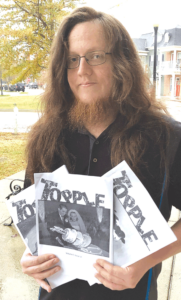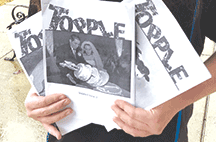
Having graduated with a degree in creative writing from St. Andrews Presbyterian College in North Carolina, Gregory Gray couldn’t have guessed his future vocation would lie in creating puzzles, not poetry. He finds, however, that the two disciplines share several parallels.
“My preference is poetry that has limitations built into it, whether that is a rhyme scheme or syllable restraint. You have to tweak what you’re creating in order to fit the structure in question,” he said. “In that sense, creating a Sudoku puzzle and writing a sonnet is the same thing. Someone else came up with the skeleton, but you’re bringing it to life in a new way.”
That “new way” is key to Gray’s niche in the business. He doesn’t simply create new versions of familiar puzzles, he creates new puzzles entirely. “Most people create a new iteration of something that already exists, like crossword,” he said. “But I generate totally new experiences for people. I’m a game designer, essentially.”
Gray created and runs Topple, a digital magazine that allows people to purchase, download, print and play his original puzzles.
His initial goal was not to begin his own enterprise, but rather to sell his original puzzles to established newspapers.
“I figured they would be eager to offer a new type of puzzle, if for no other reason than to offer something local competitors didn’t,” he explained. “Turns out I was pretty naive.”
In 2015, Gray sent samples of his puzzles to hundreds of newspapers, most of which never replied. Those who did expressed regret that they lacked the space to run his puzzles or the funds to pay for them.
Undeterred, Gray kept creating puzzles, all the while working to solve his own puzzle: how to sell and distribute his games.
“Eventually it dawned on me that for every town of 10,000 whose local paper said no, maybe a couple people in that town would say yes,” Gray said. Following this realization, he adapted his business model. Rather than attempting to sell his puzzles to papers, he began targeting interested individuals.
He launched Topple magazine in 2016.
Gray doesn’t play the puzzle-making game alone. He employs a small group of people from various places around the globe to help run and support Topple.
“My artist is Estonian, the contributing puzzler is from India, and the person who ties it all together is in Europe,” Gray explained.
He found some of his talent on DeviantArt, a social networking site for artists and employers in search of artists for various projects. While it may seem challenging for a small business to manage and pay people around the world in different currencies, “I just use PayPal,” he said. The program either converts the currency for users, or allows payees to easily convert it on their end.
Being an entrepreneur involves challenges, but Gray finds his work extremely fulfilling.
“The ideas seem to come to me out of the blue,” he said. “I even had one come to me while walking on a treadmill.”
Gray enjoys the flexible nature of his self-employed lifestyle.
“People say to have a routine, but I’m not sure that really applies to everyone,” he said. “If you can master the ability to get to work whenever you decide to, the whole creative process can become very fluid.”
Although Gray sees value in establishing a routine, he says doing so is “really just about getting you in the chair to work on whatever you need to work on. It’s a sort of forced discipline.” For many people, he said, “it’s easier to make the clock your master than be your own. It obviously works, but it’s not the only way to do things.”
Flexibility is a desirable aspect of being self-employed, but the option of more than one way to do things is not popular in the puzzle world. Much of creating a puzzle, Gray said, involves “looking for holes in your design, finding alternate ways of solving the puzzle you just made.” He must work hard to create puzzles with only one solution. “Puzzle fans hate it when there is more than a single solution,” Gray said.
While how to pay employees and creating games have proven fairly easy puzzles to solve, promoting the magazine has proven more challenging.
“It’s been hard getting the word out,” Gray said. His two main goals for the future include making each issue better than its predecessor, and “making Topple more known.”
He has contacted puzzle blogs and puzzle communities, but finds they are “hard to break into.” One thing that may help was “the puzzle YouTuber Fleb did a video on Topple.” Having successfully established Topple, he continues to work on the last piece of the puzzle: promoting it.




